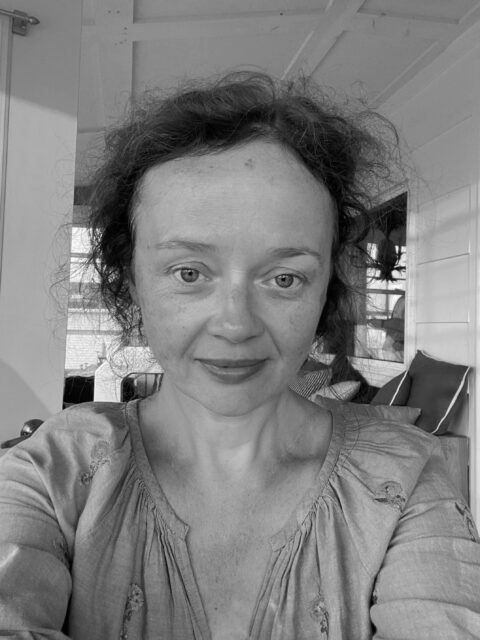Seeing is Not Believing: Visual Literacy in the Age of AI
Introduction:
Images are more real than anyone could have supposed. And just because they are an unlimited resource, one that cannot be exhausted by consumerist waste, there is all the more reason to apply the conservationist remedy. If there can be a better way for the real world to include the one of images, it will require an ecology not only of real things but of images as well. (Sontag, 1977, p. 180)
According to Susan Sontag, the power of photography has altered our understanding of reality, as “the distinction between images and things, between copies and originals” has been blurred (p. 179). In its relatively short history as a practice, photography has revolutionized how we make sense of the world by allowing us to capture, catalogue, and control it.
The process of viewing images can be likened to entering a time machine in order to remember, albeit imperfectly. Issues of image integrity, authenticity, and truth have been present in photography from its analog beginnings through to the digital revolution and now loom large in the age of AI. Concerns about consent, ownership, and privacy of those who are depicted in images, though not new to visual representation, are being raised with the advent of new AI technologies and the incessant reach of the internet changing our cultural landscapes at speeds we cannot keep up with.
The interaction between culture and technology, how they simultaneously transform each other, and how in particular this is augmented by AI is an interesting area of study for students in all anthropology courses. “The Short Anthropological Guide to the Study of Ethical AI” (2020) by Alexandrine Royer, is a valuable resource to begin considering broad questions on the topic and provides a succinct overview of the interaction in the section titled: “Culture Transforming Tech & Tech Transforming Culture” (pp.18-20). Royer reminds us of the human imprint in AI in “The Anthropology of Algorithms” (pp.20-22), reflects on the role of culture in AI in “Creating Culturally Sensitive AI” (pp.22-23), and cautions against continuing “colonial practices of oppression, exploitation, and dispossession” (p. 26) in the section titled “The Digital Divide and Decolonial AI” (pp. 23-26). The readings in Royer’s guide are accessible and current in terms of the applications examined and concerns raised. They may be assigned as material to prime students for group discussions, and individual reflections.
As the digital transformation of the image is amplified by AI, the intersections of history, memory, and truth represented in the form and content of an image are being re-examined. Algorithms, central to the use of AI technologies that rely on human intervention, do not reflect reality automatically. Therefore, the role of images as a universal language in the digital age requires a re-engagement with visual awareness.
In this set of modules, I am investigating our reliance on images as a way to understand the world at a time when the relationship between image and reality is being confounded by the phenomenon of deepfakes and image transformation technologies such as Deep Nostalgia.
Students are introduced to the study of images or photographs as material culture, they explore the evolution of the image as evidence and are presented frameworks such as Baudrillard’s Simulacrum & Hyperreality and Sontag’s Ecology of Images to develop necessary competencies for visual literacy.
The materials developed to teach visual literacy in the age of AI work can be used as standalone modules or as a series of topics in several anthropology and methodology courses currently being taught at Dawson, such as: Introduction to Anthropology (381-101-DW), Seeing Culture (Visual Anthropology) (381-219-DW), Culture on Display (Anthropology of Museums) (381-401-DW), Research Methods (300-300-DW) Integrative Seminar (Material Culture) (300-308-DW) as well as Material Culture in the Digital Age, a new course in the Society & Technology profile in the revised Social Science Program.
What is visual literacy?
Visual literacy can be defined as the ability to construct meaning from images. It is the skill we rely on first to understand the world and our place in it before learning how to speak, read, write, and count. Humanistic Futures of Learning – Perspectives from UNESCO Chairs and UNITWIN, argues for incorporating visual learning into education. According to the chapter titled “Visual literacy in the age of the image” since “children of the 21st century are visualizers”, enhancing visual awareness is especially important “to build a responsible and empowered global citizenry.” (Kárpáti, 2020, p.63)
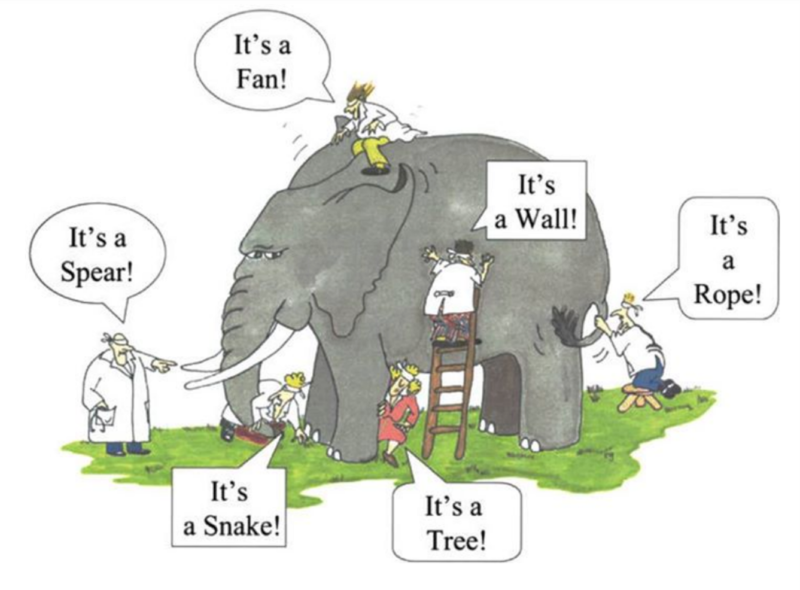
Our perception of the world is most immediately processed through our sense of vision. Today’s image-saturated environments require one to be able to encode and decode visual language with facility. As images “have the potential to become lingua franca of our daily communication, especially amongst the younger generations,” visual modes of knowledge and knowing should be introduced across all disciplines. (Kędra & Žakevičiūtė, 2019, p.1)
The literature organizes visual literacy into the following categories of skills: visual reading, visual writing, and other visual literacy skills. According to “Visual literacy practices in higher education: what, why and how?”:
- Visual reading covers skills of image interpretation/analysis, evaluation, visual perception, knowledge of visual grammar and syntax, and learned ability in visual-verbal translation.
- Visual writing covers skills in visual creation, image production and use, and in effective visual communication.
- Other visual literacy skills include visual thinking and learning skills and applied image use (such as using images ethically). (Kędra & Žakevičiūtė, 2019, p.2)
While all visual literacy skills require equal attention, in these modules I focus on the competencies of visual reading which encompass “image interpretation/analysis, evaluation, visual perception, knowledge of visual grammar and syntax and learned ability in visual-verbal translation.” (Kędra & Žakevičiūtė, 2019, p.2) Visual education is already part of the anthropology curriculum as we often rely on video and film to present ethnographic examples to our students – presenting them as text alone does not do them justice. The corresponding slides and suggested assignments are designed to support training students in the practice of looking and engaging with the onslaught of visual information in an active way.
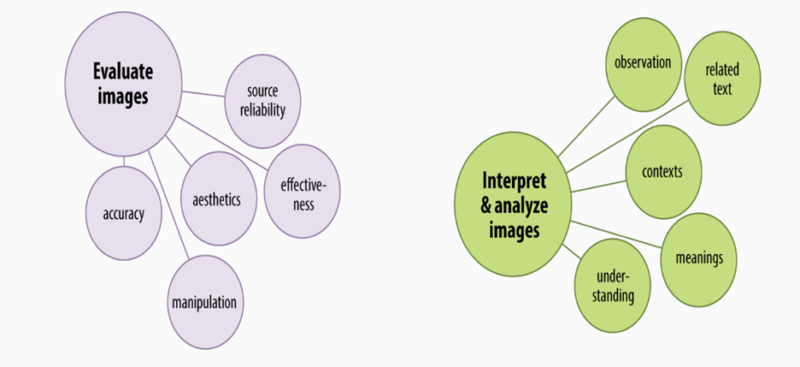
https://guides.lib.lsu.edu/visual-literacy/tips
Photograph as material culture
The first module of Seeing is not believing: Visual literacy in the age of AI, introduces students to the study of material culture in the digital age. The approach to the study of material culture is inspired by the seminal text entitled The Social Life of Things: Commodities in Cultural Perspective, edited by A. Appadurai (1986). According to the anthropology of things proposed by Appadurai, objects, such as images, don’t function only as products and commodities. They are important artifacts that construct our social lives with value recognized through their provenance.

https://www.theguardian.com/artanddesign/gallery/2014/jul/15/secret-selfies-in-the-1950s-photographer-vivian-maier-in-pictures
It is easy to appreciate how the value of physical objects may be directly derived from their material form and their relationship to places, people, and time. But what happens to their provenance when they “change between forms of representation” (Sassoon, 2004, p. 188) – from physical to immaterial? This process is not just technological, it is also cultural (p. 189) and therefore nuanced. This an appropriate entry point to begin an examination of the impacts of digital transformation on the image and how it is amplified by AI.
The approach taken here is that all representational images, whether as three-dimensional objects printed on photo paper with bent corners and visible fingerprints or as immaterial and delicate as those found on computer hard drives or those manipulated with the help of an AI, be considered Inalienable Wealth. Like “lineage names, shell body decorations and rights to land”, …. representational images may be exchanged without ever losing “their identity or that of the lineage that originally owned them.” (Weiner, 1985, p.211) The theory of Inalienable Wealth can be applied to representational images and can help us maneuver through the difficulties of considering issues of authenticity and historicity in the visual record as well as rights such as consent, privacy, and ownership. According to Weiner (1985):
The primary value of inalienability, however, is expressed through the power these objects have to define who one is in an historical sense. The object acts as a vehicle for bringing past time into the present, so that the histories of ancestors, titles, or mythological events become an intimate part of a person’s present identity. To lose this claim to the past is to lose part of who one is in the present. In its inalienability, the object must be seen as more than an economic resource and more than an affirmation of social relations. (p.210)
Students have an opportunity to understand the theory of Inalienable Wealth in application in a corresponding assignment which asks them to examine a personal photograph and consider how its content, form, location, function, and cultural significance interact. The purpose of this exercise is to situate photographs as material objects with biographies and to prepare the students to consider the significance we assign to objects such as photos when they change forms of representation, from physical to immaterial.
Image as evidence
The second module traces the evolution of the image as evidence from its analog beginnings, through the digital revolution, up to contemporary technological advancements such as AI-generated synthetic media including deepfakes and Deep Nostalgia. It examines the privileged status that images have in our culture due to factors such as reliance on sight as our most dominant sense and our trust in representational images as truth. Though images occupy an established place as mnemonic devices, the evidence they present has always been prone to manipulation, interpretation, and distortion. The story of the Cottingley Fairies is one of the earlier examples of the kind of authority that photographic images can command and may be erroneously granted.
From the earliest days of photography, images have functioned as constructed artifacts. For instance, the online exhibition of Altered Images: 150 years of posed and manipulated documentary photography presents many of the well-known disputed images in photojournalism and documentary photography. This source of representational images which had claimed to represent reality is a great tool for teaching visual awareness as it shows pre- and post-alteration images along with background information such as where they were shown and what they claimed to represent. Another great resource is Analyze a photo, a photo analysis worksheet published by the National Archives. It is ready-made to assign to students and serves to engage them in a process of “slow looking”.
The Learning Network section of the NYT provides a stock of activities for students to be used to examine our relationship with images as evidence and to enhance our critical capacity to decode visual information. Starting with their “What’s going on in this picture?” feature which invites you to “look closely at … (an) image, stripped of its caption, and (to) join the moderated conversation about what you and other students see.” This is an interactive feature as new images are posted weekly, and their captions are revealed once the discussion about “what’s going on in this picture” has been closed. Students are invited to think about how “reading the caption and learning its back story help you see the image differently.” The NYT also has readymade lesson plans such as “Lesson of the Day” feature which includes “warm-up” questions perfect for group discussion and more questions for “discussion and writing” which are well suited for individual reflection as they invite the viewers to go further in their analysis. In addition, the articles in their “Past Tense” series “show how archival photographs can be used to tell a story about a specific event, topic, person or place, and show readers a different period of time.”
Baudrillard’s Simulacra & Hyperreality
Baudrillard’s theory provides an interesting framework for evaluating and interpreting images and AI-generated synthetic media such as deepfakes and Deep Nostalgia. The theory of Simulacra & Hyperreality can be applied to understand the effects that living in the post-modern era has on our perception of reality.
The goal of this module is to have students consider the multiple layers of meaning in visual representation (original, copy, copy of a copy, copy without original) and to reflect on how the different orders of simulacra affect our relationship with and perception of what is authentic and what is fake.
One of the consequences of living in the world of copies such as analog photographs, digital images, and synthetic media created with AI such as deepfakes, is a distorted sense of reality, which Baudrillard calls the hyperreal. Hyperreality is more real than the reality it claims to represent. As can be seen with the images of historical figures such as Maria Skłodowska-Curie and ordinary people created with Deep Nostalgia, the hyperreal, outperform the copy. Once frozen in time, the photographs suddenly come alive and the individuals they portray can blink, move their heads from side to side, and smile. The effect is mesmerizing and at the same time eerie as we don’t expect the past to be re-animated. The element of wonder is replaced by a sense of unease as we realize that the movements we are witnessing are computer-generated – a phenomenon known as the uncanny valley.
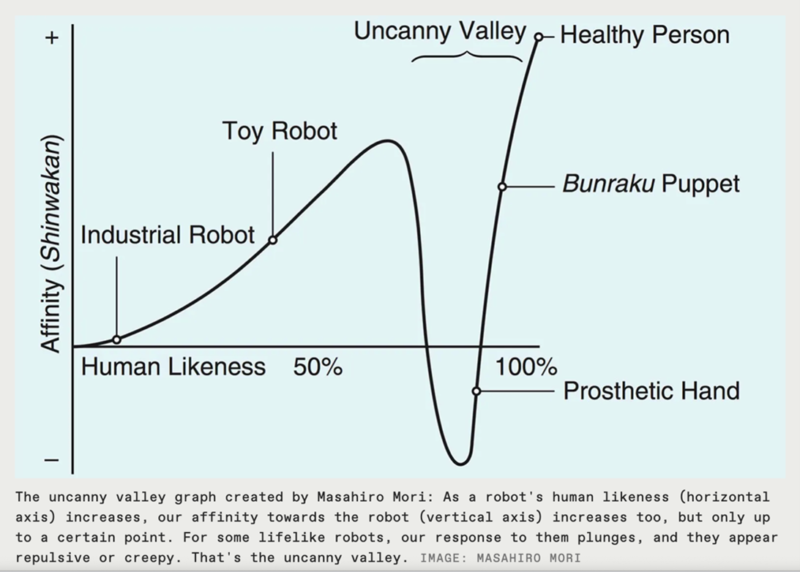
https://spectrum.ieee.org/what-is-the-uncanny-valley
The sense of unease only deepens when we learn that the historical figures which are blinking and smiling at us, may not have chosen to be represented in this fashion. The case of Frederick Douglass being re-animated by Deep Nostalgia is an important one to consider. Frederick Douglass, an ex-slave turned abolitionist, was the most photographed American of the 19th century. According to the article titled, “Frederick Douglass Used Photographs to Force the Nation to Begin Addressing Racism”, Douglas “embraced…photography” (to show)…. “what Black freedom and dignity looked like.” (Graham, 2016, par. 2) Douglas was deliberate in how he chose to be represented:

https://www.wbur.org/news/2016/07/21/picturing-frederick-douglass
In every exhibition photo,…,Douglass’s expression is nearly the same. He rarely averts his eyes from the lens, as was common in those days. He is always well dressed in sharp suits, his starched collars adorned with a natty tie. His hair is as regal and distinctive as a lion’s mane. More often than not, he is photographed alone, and he never smiles. (A notation states that in 160 photos taken of Douglass in his lifetime, he smiled only once.) (par. 7).
Frederick Douglass harnessed the power of the image to reject the caricatures of African American people common in his time. His smiling likeness made possible by the AI-generated Deep Nostalgia is disturbing as it distorts his visual record.
Neir Eisikovits’ article “The slippery slope of using deepfakes and AI to bring history back to life” considers how AI making it easier to reanimate the past will affect “how we understand history and, as a result, ourselves.” (2021, par.5) This article is a good entry point to prepare students for a discussion on ethical questions surrounding the impacts of AI-generated synthetic media such as deepfakes and Deep Nostalgia on what we consider to be credible representational images and how that problematizes our relationship with historicity.
The Simulacra & Hyperreality lesson outline provides a resource to introduce students to Baudrillard’s work, including excellent examples and ideas for assignments. “Lesson of the Day: Your Loved Ones and Eerie Tom Cruise Videos Reanimate Unease With Deepfakes” is a good resource to explore the technology behind deepfakes. The corresponding module complements the lesson outline with slides and discussion points.
Sontag’s Ecology of Images
The final module applies Sontag’s Ecology of Images as an organizing principle for understanding the dominant place of images in our culture and for acknowledging their capacity to reflect, organize and mediate reality. The framework presented borrows from Caldwell & Gedeon’s work titled “Framing photos in the digital dark age: towards a socio-technological ‘ecology of images'”. The authors identify “how images can be mapped to the ecologically-based flows of lifecycle, abundance, scale, distribution, interaction, habitat and temporality” (Caldwell & Gedeon, 2021, p. 13) in order to understand images as reflections of the real world and to examine how we interact with them.
An assignment is provided that asks students to examine the social life of an image online. They are asked to map a chosen image in its environment in order to explore its ecology.
Sontag’s Ecology of Images is to be understood as a metaphor “which seeks to locate how and why images operate in certain ‘environments’ or systems of meaning.” As shown in the diagram below, an image exists in a set of contexts that are mediated through “political, economic, technical, cultural social, legal discourses and systems.” (Manghani, 2013, p.1) History is an important variable in the framing of the image along the past, present, and future time continuum.
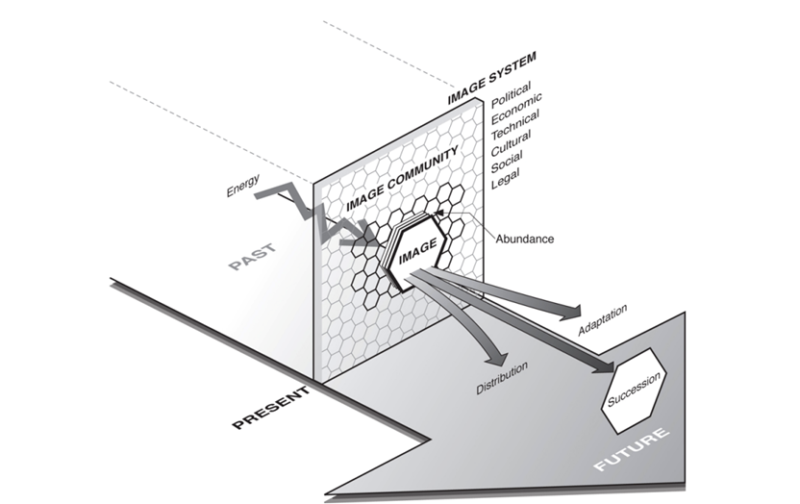
An Ecology of Images is a short article used to introduce students to Sontag’s ecology and encourage them to examine images beyond their content, to consider how they are produced, and how/why they are used to make meaning(s). The technological advancements of the digital age oblige us to reflect on the ever-present influence of visual information, to engage in the exercise of slow looking to view images as constructed artifacts that have a past, a present, and a future in order to enhance our visual literacy.
Recent manipulations of historical images as discussed in “The controversial history of colourizing black-and-white photos” highlight the need to contemplate the ethical dimensions of using AI in our visual record. The article considers how the humanity and dignity of the depicted is affected when images that portray them are colourized, such as those of prisoners of the Khmer Rouge, of AIDS victims in the 1980s, and of registration photos of Auschwitz inmates. The result of colourizing photographs is shown as having a destabilizing effect on our relationship with history, memory and how those are represented (where they meet and diverge). It seems that it is possible to cross the line of what is acceptable, and everyone agrees that adding smiles onto the faces of tortured prisoners from Security Prison 21 in Phnom Penh, Cambodia is deeply inappropriate and morally troubling.
The proliferation of AI-generated images, be it deepfakes or Deep Nostalgia, raises questions of consent, privacy, and ownership and requires us to hone our critical faculties when looking. Students are provided multiple opportunities to reflect on and discuss these ideas.
Note on Resources and References: Resources and references used in this portfolio can be found through the links above or listed at the end of each module slide deck.


